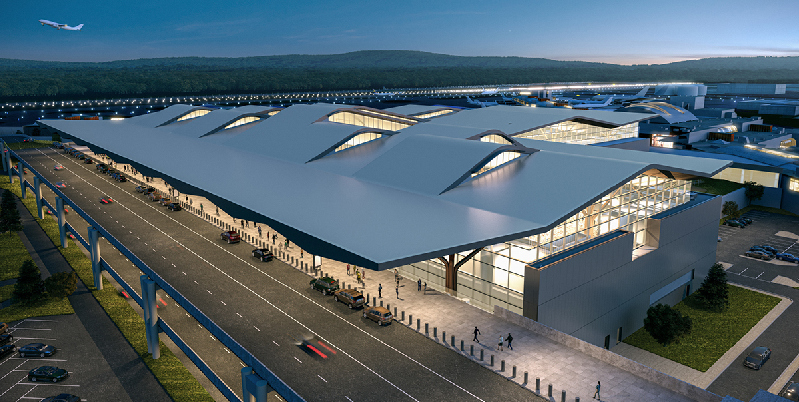
The Pittsburgh International Airport project (Pennsylvania) includes a unique bridge and tunnel experience – inspired by Pittsburgh’s Fort Pitt Tunnel and bridge experience – linking the new terminal to airside concessions, amenities and gates. A functional element such as this reflects the architectural philosophy guiding the new airport’s design. The connector bridge opens to reveal a modernized center core atrium.
The new terminal’s improved passenger experience will include cutting the time from curb to gate in half, a vastly expanded security checkpoint with more lanes – including one dedicated for families – faster baggage delivery times, additional covered parking with technology guiding patrons to the nearest open space and airfield observation areas, among other upgrades. The new terminal will also feature a more seamless international arrivals process.
The airport modernization has had a massive impact on the regional construction industry – creating direct and indirect jobs throughout the region.
More project goals are being met daily as construction enters its peak phase in preparation for the new airport’s opening in 2025, an exact date to be determined.
A first test of the state-of-the-art baggage handling system was recently conducted. This system will improve the passenger experience by significantly reducing baggage wait times. Final placement of the new terminal’s glass, a featured design element, is also expected to occur within weeks.
Airlines at PIT have unanimously supported the new terminal program. The project is funded mostly through long-term bonds that the ACAA will pay back from its operating revenue, most of which is paid by the airlines through rates and charges.
No local or state tax dollars are being used to pay for the project, which has been awarded $28.8 million in federal grants under the Bipartisan Infrastructure Law. The law includes funding for national critical infrastructure, such as airports.
Built as a hub for US Airways 32 years ago, the current terminal was built at a time when 80% of the total passengers were connecting and 20% were travelers heading to or from Pittsburgh. Today, 95% of the total passengers are heading to and from Pittsburgh and 5% are connecting.
With today’s facility built for those connecting passengers, the terminal has a cramped main checkpoint, eight miles of baggage belts and insufficient parking with costly operations and maintenance.
Fay, S&B USA Construction is one of several contractors responsible for the construction.



 Join our thriving community of 70,000+ superintendents and trade professionals on LinkedIn!
Join our thriving community of 70,000+ superintendents and trade professionals on LinkedIn! Search our job board for your next opportunity, or post an opening within your company.
Search our job board for your next opportunity, or post an opening within your company. Subscribe to our monthly
Construction Superintendent eNewsletter and stay current.
Subscribe to our monthly
Construction Superintendent eNewsletter and stay current.